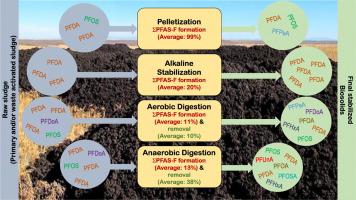Science of the Total Environment ( IF 8.2 ) Pub Date : 2020-09-21 , DOI: 10.1016/j.scitotenv.2020.142431 Narasimman Lakshminarasimman , Sarah B. Gewurtz , Wayne J. Parker , Shirley Anne Smyth

|
Poly- and per-fluoroalkyl substances (PFAS) are an emerging class of anthropogenic contaminants whose occurrence has raised concerns with the beneficial reuse of biosolids from wastewater treatment. This study evaluated the behavior of thirteen PFAS in nine Canadian sludge treatment systems including pelletization, alkaline stabilization, aerobic and anaerobic digestion processes. The composition of the overall PFAS-fluorine (ΣPFAS-F) loading in a system fed with only primary sludge was dominated by perfluorodecanoate (PFDA), whereas systems with blended primary and waste activated sludge feeds had a mix of short and long chain PFAS in raw sludges and treated biosolids. An increase in average ΣPFAS-F mass flow was observed through pelletization (19% formation) and alkaline stabilization (99% formation) processes indicating negative removal or contaminant formation. One of the two aerobic digestion systems and three of the five anaerobic digestion systems showed modest reductions (< 40% removal) in ΣPFAS-F loading. Long chain PFAS such as perfluorodecanoate (PFDA) and perfluorooctane sulfonate (PFOS) exhibited a wide variation in behavior ranging from substantial formation (> 75% formation) to modest removal (42% removal) in the surveyed systems while short chain perfluoropentanoate (PFPeA) mass flows increased through the three systems where they occurred. Overall, the contaminant mass balances revealed that there were significant changes in mass flows of the target PFAS through all kinds of sludge treatment systems. The results of this study on PFAS fate through sludge processing can inform future global PFAS risk management activities as well as sludge treatment considerations.
中文翻译:

加拿大污泥处理系统中全氟烷基物质的去除和形成-质量平衡方法
聚氟烷基和全氟烷基物质(PFAS)是一类新兴的人为污染物,其产生引起人们对废水处理中生物固体的有益再利用的关注。这项研究评估了加拿大9种污泥处理系统中13种PFAS的行为,包括制粒,碱稳定,好氧和厌氧消化过程。仅含初级污泥的系统中总PFAS-氟含量(ΣPFAS-F)的组成主要由全氟癸酸酯(PFDA)决定,而混合了初级和废料活性污泥进料的系统中,短链和长链PFAS混合存在生污泥和处理过的生物固体。通过造粒(19%的形成)和碱性稳定化(99%的形成)过程观察到平均ΣPFAS-F质量流量增加,表明去除了负离子或形成了污染物。两个有氧消化系统之一和五个厌氧消化系统中的三个显示出ΣPFAS-F装填量的适度降低(去除率<40%)。长链PFAS(例如全氟癸酸酯(PFDA)和全氟辛烷磺酸酯(PFOS))在所研究的系统中表现出很大的变化,从基本形成(> 75%形成)到适度去除(42%去除),而短链全氟戊酸酯(PFPeA)通过发生它们的三个系统,质量流量增加了。总体,污染物质量平衡表明,通过各种污泥处理系统,目标PFAS的质量流量发生了显着变化。通过污泥处理进行的PFAS命运研究的结果可以为将来的全球PFAS风险管理活动以及污泥处理注意事项提供信息。











































 京公网安备 11010802027423号
京公网安备 11010802027423号